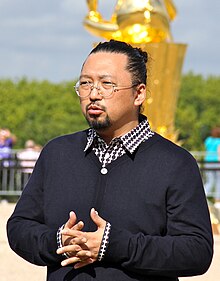Takashi Murakami
| Takashi Murakami | |
|---|---|

Takashi Murakami at the Palace of Versailles 2010
|
|
| Born |
Takashi Murakami 1 February 1962 Tokyo, Japan |
| Nationality | Japanese |
| Education | Tokyo University of the Arts |
| Known for | Contemporary art |
| Movement | Superflat |
Takashi Murakami (村上 隆 Murakami Takashi?, born February 1, 1962) is a Japanese contemporary artist. He works in fine arts media (such as painting and sculpture) as well as commercial media (such as fashion, merchandise, and animation) and is known for blurring the line between high and low arts. He coined the term superflat, which describes both the aesthetic characteristics of the Japanese artistic tradition and the nature of post-war Japanese culture and society. Superflat is also used as a moniker to describe Murakami’s own artistic style and that of other Japanese artists he has influenced.
Murakami is the founder and President of Kaikai Kiki Co., Ltd., through which he manages the careers of several younger artists and organizes the biannual art fair GEISAI.
Takashi Murakami was born and raised in Tokyo, Japan. From early on, he was an enthusiastic follower of animation and manga (Japanese comics), and aspired to one day work in the animation industry. He attended T.U.A Tokyo University of the Arts, originally seeking to acquire the drafting skills necessary to become an animator, but eventually majored in Nihonga, the ‘traditional’ style of Japanese painting that incorporates traditional Japanese artistic conventions, techniques and subjects. Though he would go on to earn a Ph.D. in Nihonga, he gradually became disillusioned with the field’s insular, highly political world and started to explore more contemporary artistic styles, media, and strategies.
Murakami was unsatisfied with the state of contemporary art in Japan, believing it to be “a deep appropriation of Western trends.” Thus, much of his early work was done in the spirit of social criticism and satire. Efforts from this period include performance art (Osaka Mixer Project, 1992), parodies of the “message” art popular in Japan in the early 90’s, (DOBOZITE DOBOZITE OSHAMANBE, 1993), and conceptual works (e.g. Randoseru Project, 1991). He also began developing his own pop icon, “Mr. DOB,” which would later develop into a form of self-portraiture, the first of several endlessly morphing and recurring motifs seen throughout his work. Though he garnered attention, many of his early pieces were not initially well received in Japan.
...
Wikipedia
